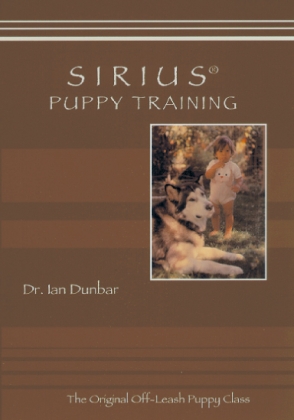Topics include: Socialization. Fearful and/or Aggressive Pups. Handling. Communication. Sit, Down & Stand.
SCIENCE-BASED DOG TRAINING (WITH FEELING)

The development of off-leash, puppy/adolescent, socialization and training classes caused a paradigm shift in dog training away from the on-leash, physical restraint/prompt/punish methods of competition/working training to whelp an entirely new field of Pet Dog Training. However, after nearly 30 years, pet dog training is in dire need of re-invention. Off-leash, science based techniques were unparalleled for 20 years or so but over the past decade, pet dog training has gone downhill.
Certainly, the fun factor and dog-friendliness of pet dog training has increased over the years, but criteria and standards have dropped dramatically. Many owners become frustrated with lack of success and so, seek help elsewhere — often adopting aversive techniques, thinking (erroneously) that physical domination and pain will be more effective. In reality, science-based training is effective regardless of the choice of training tool. However, few owners are being taught reliable verbal off-leash control without the continued need of training tools. Whereas it is easy for dog owners to find beginning lure/reward and beginning clicker training classes, seldom are they taught how to completely phase out training tools, such as lures, clickers, food rewards, collars and leashes. Hence, lures become bribes and compliance often becomes contingent on the owner having food lures and rewards, or the ability to physically restrain or punish.
Initial training appears to go well but then surprisingly quickly, without reliable off-leash control, everything falls apart during adolescence. Seemingly insignificant behavior problems of puppyhood become major reasons for surrender or abandonment.
Adolescent dogs become inattentive, distracted, anxious, fearful and maybe aggressive to other dogs and people, causing on-leash manners and off-leash reliability take a precipitous nosedive. Consequently, walks and romps in the park become less frequent, which impacts enormously on the dog’s quality of life.
All of these developmental problems are utterly predictable and quite easily preventable. Successful pet dog training is all about extremely early socialization and training, ongoing socialization and training and establishing off-leash reliability in order to adequately prepare puppies to successfully navigate adolescence. It’s all about adolescence, (hence, my two Adolescent Dog seminars scheduled for Orlando and San Francisco).
As I see it there are four huge areas of concern that need to be addressed and resolved before science-based dog training reaches “tipping point” and is universally and permanently acknowledged, accepted and practiced by dog owners and trainers. These issues will be the focus of my seminar series this year and next.
The incredible opportunities of puppyhood are still largely wasted. Prevention is easier (and much quicker) than cure but we are still not preventing the major reasons for surrendering dogs to shelters, namely, house-soiling problems, destructive chewing, excessive barking and separation anxiety. Moreover, socialization is pitifully and scarily inadequate. We are not even coming close to preparing puppies for adolescence and successfully preventing fearfulness and aggression.
Temporary training tools have become permanent management tools. Few owners progress beyond the initial stages of science-based training and fail to phase out lures and prompts, or clicks and food rewards. Few owners achieve reliable off-leash verbal control without the continued need of training aids and especially for times when the dog is at a distance of distracted. Thus few owners learn how to control their dog when off-leash at home, on walks or in the park.
Computer-generated learning theory has many severe constraints when applied in dog training. Schedules of reinforcement and punishment need to be completely re-evaluated in terms of effectiveness and expediency in pet dog training. Consequences are binary — from the dog’s perspective, either things get better, or they get worse, yet far too many owners and trainers focus on how things got better or worse in terms of choice of training tool (praise, food, toys, reprimands, jerks, shocks, etc.), or psychological principle (positive/negative reinforcement/punishment). Additionally, far too many trainers practice only half of binary feedback (reward-only or punishment-only). Teaching owners how to stop undesired behavior is essential, otherwise they will resort to aversive techniques. Undesired behavior may be effectively inhibited and eliminated without the use of aversive punishment.
Dog training is in danger of losing its soul. Far too many trainers have adopted impersonal, quantum consequences (clicks, treats, jerks and shocks) in lieu of verbal feedback. Trainers have become technicians, which although beneficial for refining timing or learning how to set criteria, lacks feeling when teaching people to develop relationships with their dogs. Just because computers had to dispense quantum kibble and shocks as consequential feedback does not mean that we need follow suit. Also, just because we need to adhere to scientific criteria does not mean that we cannot talk to our dogs. Moreover, by using instructive and analogue verbal feedback, people may transcend the training abilities of any computer. Well-timed quantum feedback only provides information vis a vis the desirability of specific behaviors, whereas a single word may provide the dog with several pieces of information: whether the behavior is desirable or not, the degree of desirability or potential danger of the behavior, plus specific instruction for how the dog may immediately correct undesirable behavior.










